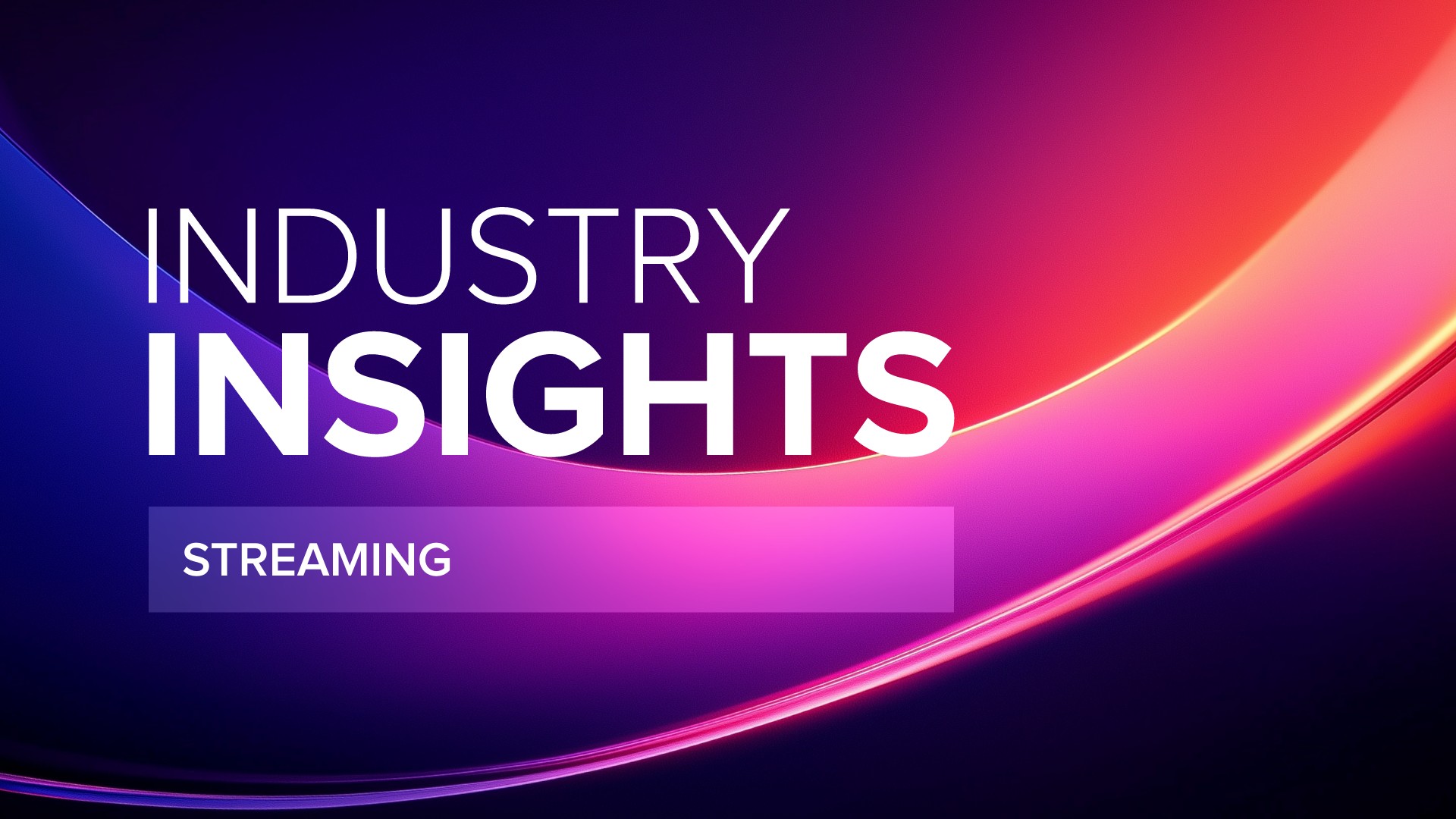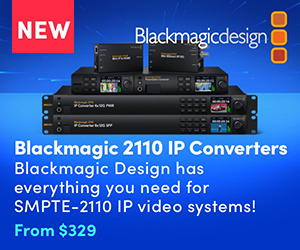Industry Insights: Is the FAST bubble about to burst or evolve

Subscribe to NCS for the latest news, project case studies and product announcements in broadcast technology, creative design and engineering delivered to your inbox.
As the streaming ecosystem matures, FAST (free ad-supported streaming television) and CTV (connected TV) are continuing to receive plenty of attention as potential growth drivers.
In this second installment of the Industry Insights series on streaming, broadcast vendors explore how FAST has evolved from a niche offering to a powerful direct-to-consumer and monetization model, as well as how connected TV platforms are changing distribution strategies.
The discussion examines whether FAST has reached saturation, what opportunities remain for non-traditional broadcasters, such as sports teams and educators, and how providers balance user experience with revenue needs. It also addresses the technological hurdles that remain as connected TV becomes a dominant force in viewer engagement.
Key takeaways from this Industry Insights roundtable
- FAST’s growing pains: While FAST adoption remains strong, market saturation is prompting providers to focus on niche content, better monetization strategies, and smarter channel packaging.
- Connected TV’s rising influence: Connected TV platforms are increasingly shaping viewer access and ad strategies, creating new advantages — and new competitive challenges — for content owners.
- User experience under pressure: Monetizing FAST without alienating viewers requires balancing ad load, maintaining content quality, and using advanced monitoring and ad insertion technologies.
- Opportunities for non-traditional players: Sports teams, educational institutions, and corporations are leveraging FAST to build audience loyalty and explore alternative revenue streams with lower entry barriers.
- Technological hurdles persist: Seamless connected TV integration still faces challenges around platform fragmentation, latency, content synchronization, and evolving content storytelling conventions.
How has FAST evolved within the streaming ecosystem?
Roberto Musso, technical director, NDI: FAST has rapidly evolved, especially as consumers seek more budget-friendly streaming options. FAST channels are now offering linear, scheduled programming with on-demand content, mirroring traditional TV but with the benefit of streaming flexibility. FAST has leveraged advances in cloud-based infrastructure and real-time IP video delivery to scale quickly and provide an enhanced viewing experience.
Anupama Anantharaman, VP, product management, Interra Systems: FAST platforms have accelerated the innovations we’ve seen in ad insertion, data monetization, and personalized viewing experiences. To ensure seamless dynamic ad insertion, media service providers have to maintain ad integrity, comply with various streaming formats, and monitor content throughout their workflows. As FAST platforms shift toward data-driven advertising, the demand for advanced ad analytics and targeted solutions is growing, accelerating the need for strategic partnerships within the industry to ensure a better, more dynamic, and engaging FAST experience for viewers.
Michael Demb, VP, product strategy, TAG Video Systems: The FAST model has matured into a viable and competitive one, offering direct-to-consumer and ad-supported accessibility that appeals to a wide demographic. Content owners with niche content can now monetize it in more ways than ever by using FAST to complement both traditional and digital distribution strategies.
Lucas Bertrand, founder and CEO, Looper Insights: FAST began as a valuable avenue for independents to monetize back catalogues through emerging distribution channels. But as major studios recognized the opportunity and consolidated their IP into branded channels, they quickly came to dominate limited FAST real estate, often at the expense of smaller players. With platforms streamlining channel offerings, success in FAST now hinges on strategic merchandising and visibility – especially as the money follows the IP.
Is FAST a bubble? Has it reached a saturation point? Or are there still opportunities?
Paul Calleja, CEO, GlobalM: FAST is still evolving, and while some markets are experiencing saturation, there are emerging opportunities in niche content, localized programming, and interactive advertising. The expansion of FAST beyond entertainment, into areas like corporate communications, education, and live events, indicates that growth potential remains. The challenge lies in maintaining content quality and ensuring an ad load that doesn’t degrade the user experience.
Chris Clarke, CRO and co-founder, Cerberus Tech: While there is a lot of FAST content out there, saturation depends on the audience and the niche. The initial wave of expansion may be over for generic channels, but new opportunities continue to emerge in underserved verticals such as regional sports, cultural programming, and corporate and educational content. As the FAST space matures, success will hinge on smarter targeting, better content packaging, and operational models that allow creators and rights holders to launch channels quickly, adapt them over time, and monetize across different endpoints without being locked into a single vendor or platform.
Cees van Versendaal, COO, MwareTV: FAST is a buzzword for a very old concept: advertising-supported television. So you have the fundamental challenges of acquiring or creating attractive content, then building an audience before it becomes a real (financial) value to advertisers and the streaming platform itself. FAST mainly remains a solid proposition in the US due to good CPMs, and even more importantly, high ad fill rates.
Andrew Ward, business development manager, Cinegy: From our perspective, FAST is essentially commercial television repackaged. The only real difference is how advertisements are delivered, but from the consumer viewpoint, the experience remains fundamentally the same. While I believe FAST represents a viable path forward, labeling it as a revolutionary concept risks undermining its credibility.
Roger Franklin, chief strategy officer, LTN: FAST revenues are rising, but to stand out, platforms need more live content. New automation across live channel creation, server-side ad insertion (SSAI) and delivery is now helping content owners scale premium live news and sports across digital, boosting viewer engagement and revenue. Media companies can now automate the entire FAST workflow in hours, not days, driving cost-efficiency and accelerating time to market.
James Gilbert, VP, sales and marketing, Pixel Power: It does now feel that FAST is getting towards saturation point, although the bubble is more likely to transform into something else rather than go “pop.” There are certainly question marks over the sustainability of some FAST channels given the audience experience (which can sometimes be a little crude), the ROI offered to creators, and the fact that these channels further dilute overall advertising revenue and fragment the market. That said, opportunities still remain for smaller content creators wishing to reach international audiences with niche content, but they may choose alternative content monetization models provided by platforms such as YouTube.
Graham Sharp, VP, global sales and marketing, BCNexxt: Yes, I believe it is. FAST is no different to linear TV in terms of its technical requirements, but the return is much less. The economic success of FAST is dependent on keeping costs down by automating the whole process from schedule creation to ad placement and ad sales. As providers adopt more automated solutions, such as BCNExxt’s Vipe, FAST becomes more viable, but I think a key by-product is that broadcasters and content owners learn how to save money across their other channels.
What FAST opportunities exist for non-traditional broadcasters, like sports teams, education, corporate, etc.?
Roberto Musso: Niche content offers a major opportunity for non-traditional broadcasters. Although FAST follows similar scheduling to traditional TV, it allows consumers to search for and stream content specific to their interests – for example, sports enthusiasts can stream live events; educational institutions can offer age-specific programming. FAST provides non-traditional broadcasters with an alternative revenue stream that leverages targeted advertising, providing a scalable, low-barrier entry into broadcasting.
Chris Clarke: Non-traditional broadcasters — especially those with regular live or on-demand content and a clear audience base — are in a strong position to benefit from FAST. Sports teams can maintain year-round engagement with fans. Universities can extend the reach of events and lectures. Corporations can improve internal comms or create thought leadership channels. What makes FAST viable for these groups is access to infrastructure that’s cost-efficient, easy to use, and able to handle everything from ingest to distribution, without the need for a dedicated engineering team.
Cees van Versendaal: FAST is, by definition, a commercial service, paid for by advertising. That really does not work for special interest services: corporate users, for example, will see the whole service as providing information and sales stimulus for the services, without the need for FAST’s programs with commercial breaks structure.
Peter Mayhead, CEO, Pebble: Provided — and this is a big ask — they have the resources to sell and manage the advertising, FAST is a very attractive proposition. By using the cloud, operators can quickly establish channels without heavy capital expenditure — as an exhibition “trick”, for years we have shown how you can get a new channel on air within minutes. Content owners are increasingly looking to deliver direct to consumers, and FAST is a good way to do it.
Roger Franklin, chief strategy officer, LTN: FAST offers an alternate distribution channel for sports organizations to monetize live content. Real-time customization technologies and automated FAST workflows make it simpler and more affordable for sports organizations to spin up tailored versions of live events for FAST distribution. Even the smallest leagues can now access some of the same event customization tools that the biggest players use, making it easier to expand coverage across global digital platforms.
Lelde Ardava, COO, Veset: Without the need for specialized hardware, niche companies with a supportive consumer foundation can launch streaming-driven FAST channels with little experience. Monetization models are evolving, making FAST channel creation and maintenance much simpler, with most content providers only needing a cloud-based workflow to get started. Partnership collaboration is also a promising area of development, with many non-traditional broadcasters beginning to partner with bigger brand names to make their start in the FAST landscape.
Kev McCormick, product experience lead, Accedo: These non-traditional players in particular should be looking to repurpose content and create FAST channels grouping specific types of content, such as all news relating to a specific sport or even sports team, or content that is seen as motivational, for example. FAST channels haven’t thought like this until recently, but we are only touching the surface. The next stage is to integrate AI for more advanced personalization.
Lucas Bertrand: FAST offers non-traditional broadcasters a chance to grow their audience by controlling how quickly content becomes available after live or tentpole events. By shortening the window between original airing and FAST distribution, these players can stay top-of-mind and drive higher engagement. As the model matures, smart windowing strategies will be key to unlocking reach and relevance in an increasingly crowded landscape.
Christopher J Bell, global strategy leader, media and entertainment, games, and sports, AWS: FAST works well in part because audiences are seeking novelty without too great a commitment. Because of the revenue opportunity which scales with consumption, FAST is ideal for experimentation with novel programming like all of a team’s non-game content, a full college course presented class by class, or seasonal or themed content is all possible at limited risk. All have the potential to serve as effective lead generators for more exclusive and even subscription-based content as well.
James Gilbert: The obvious benefit of FAST is the ability to create and deploy channels quickly and at lower cost than traditional methods. For sports teams, this opens up the ability to focus on fan engagement by creating and distributing supplementary content (and associated promotions) cost effectively, keeping fans invested between match days and driving additional revenue. For the education and corporate markets, FAST is a cost-effective alternative channel for that can improve international reach, educate and inform, and bolster brand loyalty.
Mark Donnigan, strategic marketing head, Netint: The lower barrier to entry compared to subscription service models makes it attractive for building brand loyalty and new revenue streams. However, due to the low per user revenue generated, FAST requires more efficient transcoding. This is where IaaS platforms like the new VPU-accelerated Cloud from Akamai can be beneficial.
Matt Smith, chief evangelist, Akta: FAST represents a significant opportunity for brands to build presence, audience and potentially revenue. Viewers are increasingly seeking out specific types of content that can be offered in new methods through which they can engage. This can be a sports league with a connected TV (CTV) channel, a broadcaster with a purpose built CTV channel or a local broadcaster offering content that may not have had enough time on a broadcast to air, where a CTV channel could offer an environment for another (perhaps longer) look at a particular subject or topic to be viewed.
How do content providers balance user experience with ad revenue on FAST platforms?
Roberto Musso: Maintaining audience engagement is the key to striking a balance between the content and ads viewers see. Understanding FAST platforms cater to niche interests, content providers must create targeted and relevant ads that keep viewers hooked. This allows providers to maximize monetization opportunities.
Costa Nikols, strategy advisor, M&E, Telos Alliance: The “F” in FAST platforms stands for “free”. The delivery of advertisements to viewers is generally prioritized over user experience. FAST platforms employ varying methods of ad control, based on the revenue-sharing model between the service provider and content owner, and the subscription level. Ads, originating from an ad server, are dynamically delivered to the playback device using a unique identifier. This complexity hinders the ability to ensure consistent conformance or monitor the quality of experience. Issues such as fluctuating audio levels and inconsistent quality across channels are common.
Peter Mayhead: Consumers have got used to the rhythms of commercial television: restrictions on commercial breaks vary from country to country, but viewers grow to understand and accept them. Streaming services are a free-for-all so the temptation is for operators to flood the platform with advertising, but too many commercials will quickly alienate viewers, who have plenty of other choices. Service operators have to sell those commercial slots, too, and a large inventory often tends towards heavy repetition, again a massive turn-off for audiences.
Anupama Anantharaman: Content providers can balance user experience with ad revenue on FAST platforms by leveraging multi-point monitoring, which ensures both seamless playback and ad performance. Continuous monitoring enables content providers to maintain high-quality viewing experiences by quickly identifying and resolving issues in ad playback, which is essential for audience retention in a free-to-view model. At the same time, it ensures ads are inserted correctly, fully viewed, and compliant with advertiser agreements — which directly impacts and optimizes revenue streams.
Lelde Ardava: The best place to start in dealing with this issue head on would be to ensure high-quality content delivery that is based on an efficient, reliable and future-proofed workflow. New compression standards such as JPEG XS are leading the way for a new era of content delivery, offering lower latency, higher quality and more reliable integration with multicast and multi-platform content streaming. User centric ad experiences such as contextual advertising and server-side-ad-insertion (SSAI) are also providing a host of new opportunities for content providers, allowing for relatable, interactive and non-interruptive ads during content distribution.
Kev McCormick: Often you will see a certain amount of initial pushback but ultimately what we are seeing is that users who buy the cheapest level of subscription are happy to accept they will have ads. That said, it is important to ensure it doesn’t disrupt the viewing experience. For FAST the experience should really be similar to linear TV where ad breaks happen at specific times within the content.
Christopher J Bell: Data collection and proper analysis is essential to crafting effective FAST strategies. User preferences vary by programming type and ad relevance. Finding the right mix of ad load and style, including ads which can share screen space with the ongoing program is a matter of careful analysis of user behavior in response to specific content and ad strategy.
James Gilbert: I think that depends very much on the channel in question and the brand behind it. There seems to be a good level of audience maturity when it comes to FAST channels insofar as audiences do not expect the same levels of production quality or presentation from channels being run by smaller content brands versus their more traditional and established counterparts. Conversely, the larger/more traditional broadcast brands have to make a tricky judgement call over the costs they incur in running these channels and providing an experience commensurate with their brand versus audience size and the overall value contribution of the channel.
How are connected TV platforms changing the streaming experience?
Peter Mayhead: The essential benefit of streaming is that it is available on multiple platforms: you can start watching something on a phone or tablet, continue on a desktop computer, and finish on the large television in the corner of the family room. The real role of connected TV is to provide the portal into the streaming service: choosing a streamer should be exactly the same as choosing a broadcast station or a cable or satellite channel.
Fabio Murra, SVP, product and marketing, V-Nova: Connected TV has fundamentally reshaped streaming — and we’re witnessing it firsthand. Viewer habits pushed ad spend to nearly $26B last year alone, fueled by FAST’s explosive growth and precise targeting. Yet, profitability demands smarter innovation: Bandwidth efficiency isn’t optional anymore. Using MPEG-5 LCEVC, platforms slash delivery costs by up to 40%, boosting visual quality while expanding reach.
Aaron Kroger, product marketing lead, Dalet: Connected TV platforms are redefining the streaming landscape by seamlessly integrating streaming services with traditional TV viewing habits. These platforms enhance accessibility and usability by offering features such as personalized content recommendations and app support, including FAST. By bridging the gap between linear TV and on-demand streaming, connected TV platforms create a more cohesive and user-friendly entertainment ecosystem.
Lucas Bertrand: Connected TV platforms are reshaping streaming by pushing FAST and content higher up in the user interface and making more placements available for Paid to grow ARPU. It’s interesting to watch how platforms like Roku are negotiating to sell more ad inventory and requiring content providers to contribute programming to their O&O FAST as part of broader distribution deals. This shift gives platforms greater control over monetization and driving ARPU.
What technological challenges remain for seamless CTV integration?
Roberto Musso: The primary technological challenge in connected TV integration is ensuring seamless interoperability across various platforms, devices, and content delivery systems. Latency reduction, content protection, and consistent video quality across varying internet speeds pose ongoing challenges. As more broadcasters adopt IP-based solutions, maintaining low latency and real-time synchronization for live events remains a critical hurdle.
Paul Calleja: One of the primary challenges in connected TV integration is the lack of standardization across devices and operating systems. Maintaining consistent performance across different platforms while optimizing for ad insertion and interactivity is complex. Additionally, latency issues in live content and maintaining synchronization across multiple screens continue to require innovative solutions.
Andrew Ward: The technological challenges for seamless connected TV integration are surprisingly minimal — the real hurdles lie in what we call “narrative grammar.” We can transmit content across multiple platforms and devices efficiently, but the content creation and presentation side still struggles with how to effectively structure and deliver stories across connected environments. For instance, with immersive entertainment using 360° views, how do you guide viewers where to look at critical moments? The distribution layer is capable; it’s the content layer that needs to establish new conventions for audience engagement.
Mark Donnigan: CTV challenges include platform fragmentation, cross-device measurement complexities, and ensuring privacy-compliant ad delivery. Addressing these requires standardization efforts and robust backend systems capable of adapting content for diverse devices. Utilizing LCEVC can help deliver consistent high quality across varied CTV hardware, while efficient VPU processing handles the necessary format conversions needed for 4K UHD.
Subscribe to NCS for the latest news, project case studies and product announcements in broadcast technology, creative design and engineering delivered to your inbox.








tags
Aaron Kroger, Accedo, Adtech, AI, Akta, Amazon Web Services, Andrew Ward, Anupama Anantharaman, Artificial Intelligence, AWS, BCNexxt, Cees van Versendaal, Cerberus Tech, Chris Clarke, Christopher J Bell, Cinegy, Connected TV, Costa Nikols, Dalet, dynamic ad insertion, Fabio Murra, Free Ad-Supported Streaming Television (FAST), GlobalM, Graham Sharp, Interra Systems, James Gilbert, Kev McCormick, Lelde Ardava, Looper Insights, LTN, Lucas Bertrand, Mark Donnigan, Matt Smith, Michael Demb, MwareTV, NDI, Netint, Paul Calleja, Pebble, Personalization, Peter Mayhead, Pixel Power, Roberto Musso, Roger Franklin, Server-Side Ad Insertion, TAG Video Systems, Telos Alliance, V-Nova, Veset
categories
Heroes, Industry Insights, Streaming, Voices